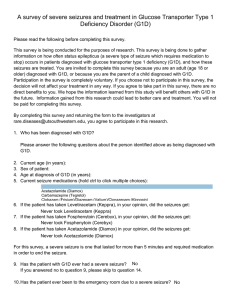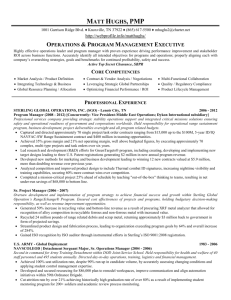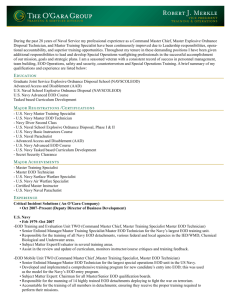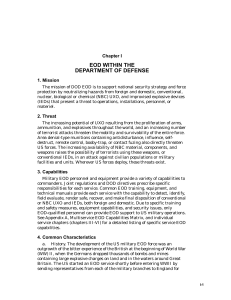MARINE CORPS EOD OPERATIONS Chapter IV 1. Interservice Responsibilities
advertisement
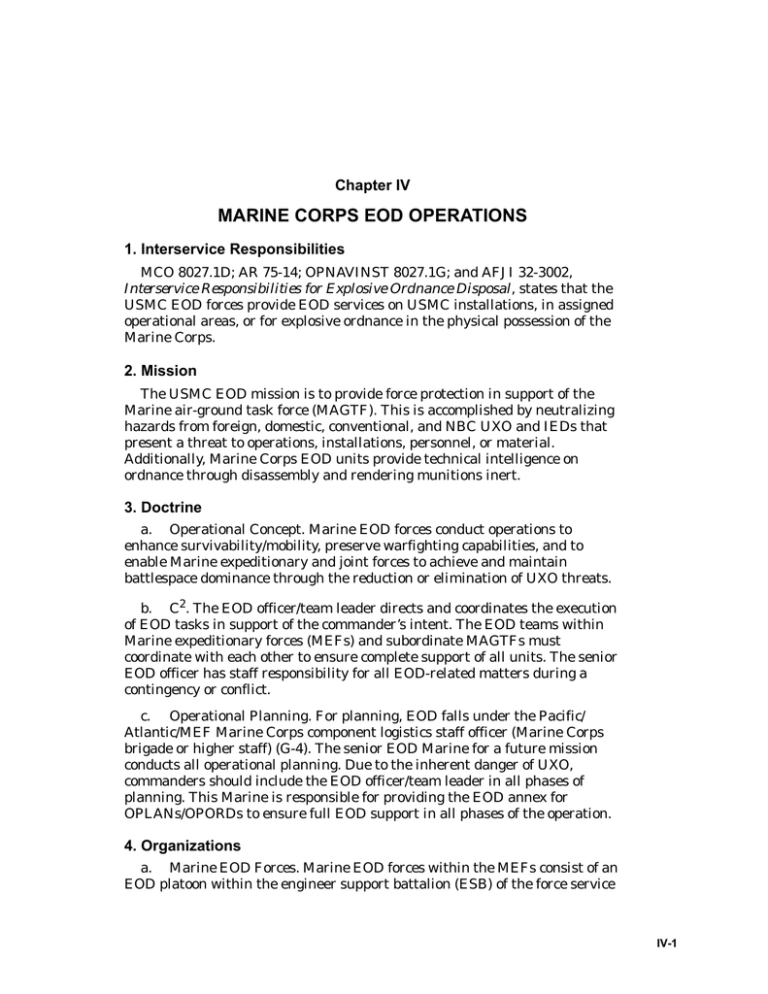
Chapter IV MARINE CORPS EOD OPERATIONS 1. Interservice Responsibilities MCO 8027.1D; AR 75-14; OPNAVINST 8027.1G; and AFJI 32-3002, Interservice Responsibilities for Explosive Ordnance Disposal, states that the USMC EOD forces provide EOD services on USMC installations, in assigned operational areas, or for explosive ordnance in the physical possession of the Marine Corps. 2. Mission The USMC EOD mission is to provide force protection in support of the Marine air-ground task force (MAGTF). This is accomplished by neutralizing hazards from foreign, domestic, conventional, and NBC UXO and IEDs that present a threat to operations, installations, personnel, or material. Additionally, Marine Corps EOD units provide technical intelligence on ordnance through disassembly and rendering munitions inert. 3. Doctrine a. Operational Concept. Marine EOD forces conduct operations to enhance survivability/mobility, preserve warfighting capabilities, and to enable Marine expeditionary and joint forces to achieve and maintain battlespace dominance through the reduction or elimination of UXO threats. b. C2. The EOD officer/team leader directs and coordinates the execution of EOD tasks in support of the commander’s intent. The EOD teams within Marine expeditionary forces (MEFs) and subordinate MAGTFs must coordinate with each other to ensure complete support of all units. The senior EOD officer has staff responsibility for all EOD-related matters during a contingency or conflict. c. Operational Planning. For planning, EOD falls under the Pacific/ Atlantic/MEF Marine Corps component logistics staff officer (Marine Corps brigade or higher staff) (G-4). The senior EOD Marine for a future mission conducts all operational planning. Due to the inherent danger of UXO, commanders should include the EOD officer/team leader in all phases of planning. This Marine is responsible for providing the EOD annex for OPLANs/OPORDs to ensure full EOD support in all phases of the operation. 4. Organizations a. Marine EOD Forces. Marine EOD forces within the MEFs consist of an EOD platoon within the engineer support battalion (ESB) of the force service IV-1 support group contained within the division and EOD forces within the Marine wing support squadron (MWSS) of the Marine wing support group. (1) The EOD Platoon of the ESB. The ESB EOD platoon is a part of the headquarters and services (H&S) company of the ESB. The ESB S-3 tasks and controls the EOD platoon. See Figure IV-1, which depicts the H&S company of the ESB. Organization and equipment for the EOD platoon provides eight fully capable teams for operations in support of the MEF. See Figure IV-2, USMC EOD Platoon, Engineer Support Battalion, for a depiction of the eight teams. These eight teams can reorganize into smaller teams and respond to separate incidents, depending upon the complexity of the UXO/IED incident. A six-man EOD team will support a Marine expeditionary unit (special operations capable) (MEU[SOC]). The MEU (SOC) is the most Headquarters and Support Company, Engineer Support Battalion S-1 Section S-2/S-3 Section Communication Platoon EOD Platoon Senior Enlisted Advisor Construction Platoon S-4 Section Medical Platoon Field Mess Section Figure IV-1. USMC H&S Company, Engineer Support Battalion Figure IV-2. USMC EOD Platoon, Engineer Support Battalion IV-2 Chaplain Section Supply Platoon commonly deployed version of a MAGTF. The Marine Corps assigns the EOD team to the MEU service support group (MSSG) operations officer. During MEU operations, the EOD team may be OPCON/TACON to a higher headquarters to facilitate the most efficient use of a scarce asset. (2) EOD Section of the MWSS. The EOD section of the MWSS consists of one officer and six enlisted personnel and primarily supports the air combat element. The MWSS EOD section is capable of providing full EOD support to an expeditionary airfield (EAF). Each team may reorganize into smaller teams and respond to separate incidents. For example, the EOD team may operate at a forward operating base, EAF, forward arming and refueling point, or may respond to a separate UXO incident. See Figure IV-3, USMC EOD Section, Marine Wing Support Squadron. b. Marine Base/Air Station EOD Forces. (1) Marine Corps Bases. The base EOD teams are under OPCON of the Assistant Chief of Staff, Operations and Training, department of the Marine Corps base. The EOD team usually consists of one officer and six enlisted and provides full EOD support for all operational and training evolutions that the base conducts. (2) Marine Corps Air Stations (MCAS). The Marine Corps assigns this EOD team as a special staff section to the air station commanding officer. This section usually consists of one officer and four enlisted personnel and provides all support in the conduct of operations and training aboard the MCAS. Marine Wing Support Squadron S-1 Section MP/Flight Line Security Department Internal Airfield Communications S-2 Section Airfield Operations Division S-3 Section EOD Section S-4 Section Motor Transport Operations Division Equipment Maintenance Department Engineer/ Operations Division Figure IV-3. USMC EOD Section, Marine Wing Support Squadron IV-3 5. Capabilities a. Marine EOD Team Capabilities. In addition to the recurring operations provided in Appendix E, all Marine EOD teams have the following capabilities— (1) Tactical Recovery of Aircraft or Personnel (TRAP). The EOD technicians assist in extracting personnel from aircraft and the recovery, rendering safe, or destruction of any remaining explosive and classified components as required. Marine EOD technicians that support/participate in a TRAP operation are under OPCON of the search team leader. (2) Base Recovery After Attack. EOD provides rapid UXO clearance after an attack to facilitate rapid reopening of an airfield for combat operations. A UXO hazard can disrupt and/or paralyze air operations and do so for long periods of time. These disruptions/interruptions to operations are particularly applicable to targets requiring rapid reopening priority. Regardless of the munitions employed against an airbase, base recovery, and, in particular, airfield recovery must take place in the shortest time possible. Multiple factors effect when and how the rendering safe and clearance of UXO occurs during a recovery mission. These factors include, but are not limited to— (a) sensitivity of the fuzing. (b) condition of the munition. (c) location of the munition. (d) priority of clearance assigned to the location. (3) Noncombatant Evacuation Operation (NEO). The EOD team neutralizes any explosive hazards capable of endangering the NEO party/ security forces or evacuating personnel. These explosive hazards can include conventional or improvised UXO. The EOD team can also destroy any contraband, weapons, or explosives brought into the site. During an NEO, the site commander normally has TACON of the EOD team for optimal utilization. (4) Humanitarian Assistance (HA) Operations. Marine EOD units conducting an HA operation provide mobile training teams. These teams destroy weapons, ordnance, and explosives, and report ordnance-related information to the proper authority. The EOD units support MAGTF internal security by responding to IEDs and by providing instruction to MAGTF units concerning ordnance identification and IED awareness. The optimal method of employing an EOD unit during an HA is by TACON to the operations officer. (5) Force Protection. The optimal method of employing EOD forces during force protection operations is by providing DS to the MAGTF. Employment of the EOD force requires application of planned and integrated security programs, including— (a) combating terrorism. (b) physical security. IV-4 (c) operations security. (d) personal protective security supported by intelligence. (e) counterintelligence (f) other security programs. The EOD force within the MAGTF normally receives direction from the force protection officer of the MAGTF. Attachment of EOD teams to subordinate units should only occur when the supported unit is separated from the MAGTF and response by individual tasking is not feasible. (6) Technical Support and Training. EOD units provide technical intelligence through exploitation of ordnance by identification, disassembly, and rendering munitions inert. Additionally, Marine EOD personnel teach awareness, response, reporting, and identification of IEDs and locally manufactured ordnance items. EOD units perform crater analysis and assist in post-blast investigations. The MAGTF can attach EOD forces to raid units to neutralize munitions/missiles. (7) Dynamic Entry. Dynamic entry involves the use of specialized technical entry methods against a specific target. EOD performs the dynamic entry mission in support of the maritime special purpose force (MSPF) and military police (MP) special response teams. Methods include the use of mechanical tools, thermal torches, shotguns, and explosives. Dynamic entry methods ensure 100 percent penetration of the target using a minimum of force, with the intent to limit collateral damage. These operations support in-extremis hostage rescue and raids to destroy or rescue equipment/ personnel in support of the MSPF or MP special response teams. (8) Disaster Areas. If a disaster strikes an area where munitions are manufactured, stored, or utilized, EOD support may allow relief forces to conduct operations and to safeguard citizens. b. Marine Corps MOOTW EOD Capabilities. During MOOTW and smaller scale contingencies, EOD forces recover, render safe, and dispose/ neutralize ammunition/UXO, and clear IEDs used by guerrilla or paramilitary units. c. MEU (SOC) EOD Capabilities. MEU (SOC) EOD units provide EOD-related capabilities in the following operations: (1) Maritime Intercept Operation (MIO). The purpose of an MIO is to board and search shipping vessels that may be handling contraband or are potentially hostile to national interests. The USMC often attaches EOD teams to a unit conducting a visit, board, search, and seize (VBSS) operation. The EOD teams search for and render safe or destroy IEDs and other hazardous devices. (2) Gas and Oil Platform (GOPLAT) Operation. A GOPLAT is an operation when the NCA dictates use of oil and gas production platforms as a staging/listening/operating base, or the US deems it necessary to capture the platform. The Marine Corps assigns an EOD team to the assault force of a IV-5 GOPLAT to neutralize IEDs and to perform special demolition procedures to destroy critical locations (if necessary). (3) In-Extremous Hostage Rescue (IHR). The Marine Corps conducts this mission to protect American and foreign lives that have been held hostage or prisoner when a point of death situation arises. The Marine Corps assigns EOD technicians to the maritime special purpose force during deployment. The assault unit EOD technicians must qualify on assault skills to operate as part of the team during all phases of the operation. During the IHR, the EOD technicians clear explosive devices and are members of the dynamic entry teams. The EOD technicians assist the person or persons tasked with breaching (establishing an entry point) to facilitate surprise and speed of entry. 6. Training a. Team Qualification Requirements. All EOD technicians are graduates of basic EOD school and possess some or all of the skills listed in paragraph b below, through MEU training rotation and follow-on training at their unit. b. MEU-Specific Courses. The following courses are MEU-specific training opportunities: (1) Specialized demolitions. (2) Dynamic entry and close-quarters battle courses. (3) Training in the urban environment. (4) Special operations exercises (taught by the Special Operations Training Group from the 1st, 2d and 3d MEF). Marines also attend Basic Airborne School, Fort Benning, GA; the Combat Divers School, Panama, FL; and the Small Boat Training Landing Force Training Center within the Pacific and Atlantic Fleets. IV-6
